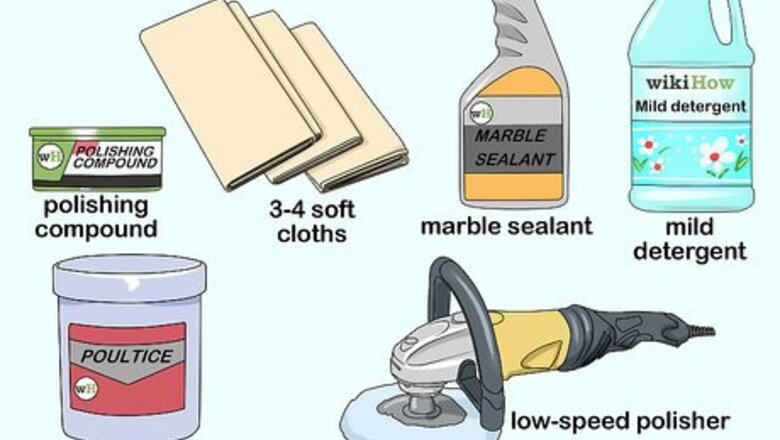
views
X
Expert Source
Bridgett PriceHouse Cleaning Professional
Expert Interview. 23 May 2019.
With a little time and elbow-grease, you can polish your natural or cultured marble and make it look new again.
Preparing Your Marble
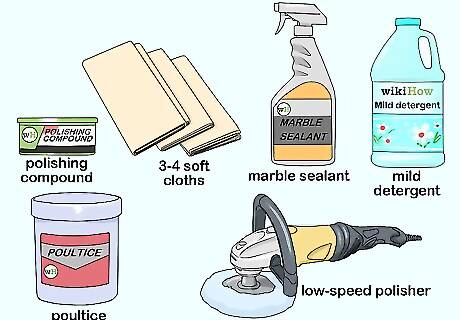
Gather your supplies. You will need a mild detergent, 3-4 soft cloths, a poultice for stain removal (optional), a polishing compound, a low-speed polisher with a felt wheel (optional), and a marble sealant. You can collect the items yourself or purchase a kit. If you have cultured marble, make sure that your product says it’s for cultured marble. If you do not have access to a polisher, you can apply your marble polish with a soft rag; however, this method is very tiring. If you have stains, remove them with a poultice before polishing. Keep in mind that if you use a poultice you will need to wait at least 24 hours to continue to the next step. Use an etch remover polishing compound if you have water rings.

Tape the area around the marble. If your marble is surrounded by other surfaces such as wood or chrome that could be damaged by the products you will use, protect them with painter’s tape. Cover wood and chrome surfaces. If you have wood floors, consider taping around the edges of the bottom of the cabinet if you will be using a spray product because the product could land on the floor.
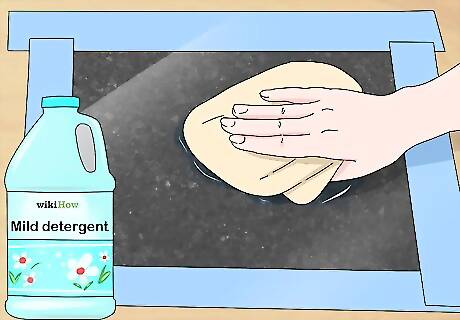
Clean the surface with a mild detergent and soft rag. Test a small area before you clean the entire slab. If you have stains, try removing them with just your detergent by gently working the area with your damp cloth over the stain.
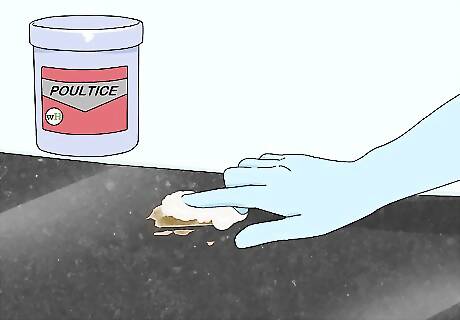
Apply your poultice (optional). A poultice will remove stains that have settled into the porous surface of your marble. Polishing your marble will not remove the stains; instead, you will be sealing them in. You can purchase a commercial poultice or you can make your own. To make a poultice, mix just enough hydrogen peroxide into flour to create a paste. You can also use a combination of one tablespoon ammonia, half a cup hydrogen peroxide while slowly adding baking soda until it forms a thick paste. Smooth the poultice onto the stain and seal it by taping plastic wrap over it. Leave your poultice on for at least 24 hours. Old stains may require more time. Determining the time needed to remove old stains is a trial-and-error process. After 24-48 hours, remove the plastic, pour a little water over the dry poultice, and wipe it away with a soft cloth. Thoroughly dry the area. If the stain persists, repeat this process again.
Using Your Polishing Compound
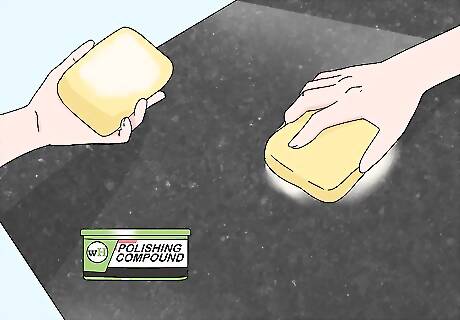
Apply a small amount of polishing compound. Consult the side of the container for proper measurements, as different products recommend different amounts. Put the compound on the small section where you will begin work. Do not apply polishing compound to the entire piece of marble at once. How much polish you should apply will depend on the type of polish you choose and the size of the space you are polishing. If you are not sure how much polish to apply, start with a little and add more as needed. It’s easier to add more than it is to remove excess.

Choose a low-speed polisher or a soft cloth. While you can use either, it takes longer to use a soft cloth, and if you do not keep up the same level of pressure it could affect your results, so a low-speed polisher might be your best bet. If you have a drill, you can replace the drill bit with a felt-top sanding disk so that you can use it as a polisher.
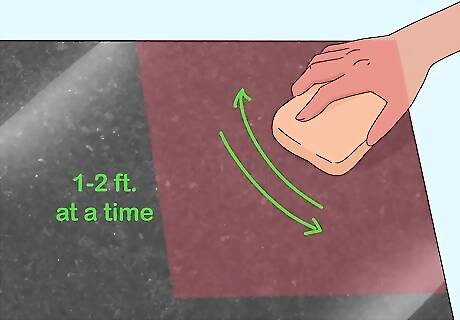
Work in small sections. Only work on one small section of 1-2 feet at a time to create an even finish and avoid having your polishing compound dry out or begin to clump up. Working in small sections also helps you evenly distribute the polish because you are able to add small amounts of polish as you go. Start in a corner and work your way around the entire area to make sure you apply an even polish. If you start in the middle, then you may miss a spot.
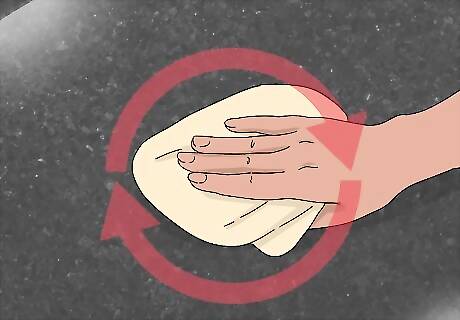
Work in the polish. If you're using a soft cloth or the soft side of a new sponge, make tight, circular movements. If you're using a polisher, slowly move it in a controlled circular motion. When you finish with the flat sides, polish the corners with a soft rag, continuing your circular movements. Use a low to medium speed if you’re using a polisher.
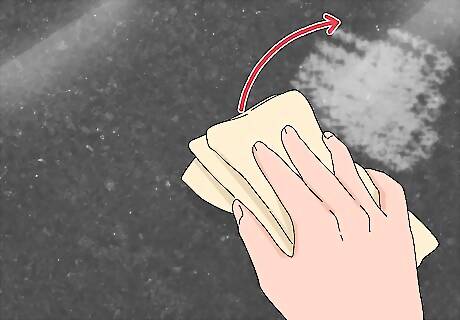
Remove the excess polish. Use a dry cloth to wipe away the residue, and then finish with a damp cloth to ensure a clean surface.

Allow your marble to fully dry. Wait 24 hours before applying your sealant. If your cultured marble still has stains or shows damage, you can polish it with a buffing compound and then again with a polishing compound. If neither of these products works, cultured marble can be wet sanded using 1,000-grit wet/dry sandpaper. Don’t try buffing compound or wet sanding on natural marble because it is more easily damaged.
Sealing Your Polished Marble
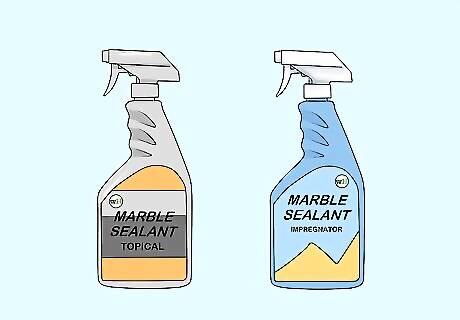
Choose your sealant. Sealants can be topical or impregnator. Topical sealants sit on top of the marble and prevent staining, while impregnators go below the surface and repel water and oils while still allowing the marble to breathe. Countertops and vanities are usually sealed with an impregnator, while floors and other types of marble may be better served by a topical sealant. Don’t seal cultured marble because it’s stronger and doesn’t need a sealant. Some cultured marbles won’t take a sealant. You don’t need to seal marble in a shower unless you plan to use products that stain. Personal care products don’t stain marble unless they’re allowed to sit. Shaving cream can cause etching, but that’s not prevented by a sealant.
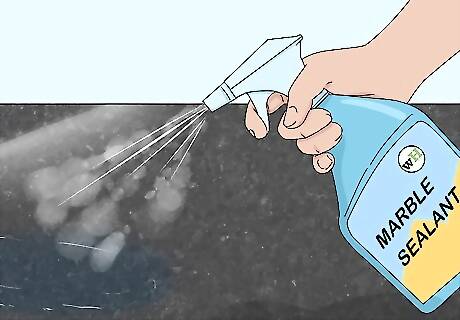
Apply your marble sealant. A sealant won't prevent all stains, but will provide some protection to your marble surface. You can purchase marble sealant in a spray bottle at a hardware or home goods store. As you spray on your sealant, make sure that the entire surface of your marble is wet. Don’t let the sealant fully dry or it will streak. You can add water to the sealant by spraying on water or dabbing with a damp cloth. Adding water to sealant that is drying too fast will prevent streaking.
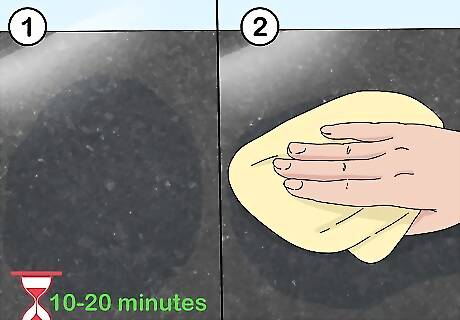
Wipe off the sealant residue. Consult your container for the application time. After your sealant has been on the marble for the recommended time, use a dry cloth to wipe the surface dry. Most sealants recommend a wait time of 10-20 minutes. If you let it sit longer than the recommended time, the sealant will streak. If your sealant recommends two applications, then repeat the steps once.
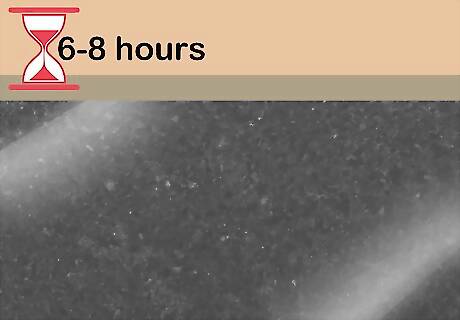
Wait for your marble to dry. Allow your marble to sit for 6-8 hours. Avoid using or placing anything on your marble until it has completely dried because the seal needs time to set. You don’t want to risk getting the sealant that’s seeped into the surface wet while it’s still fresh. Marble should be sealed every 6-12 months.
















Comments
0 comment